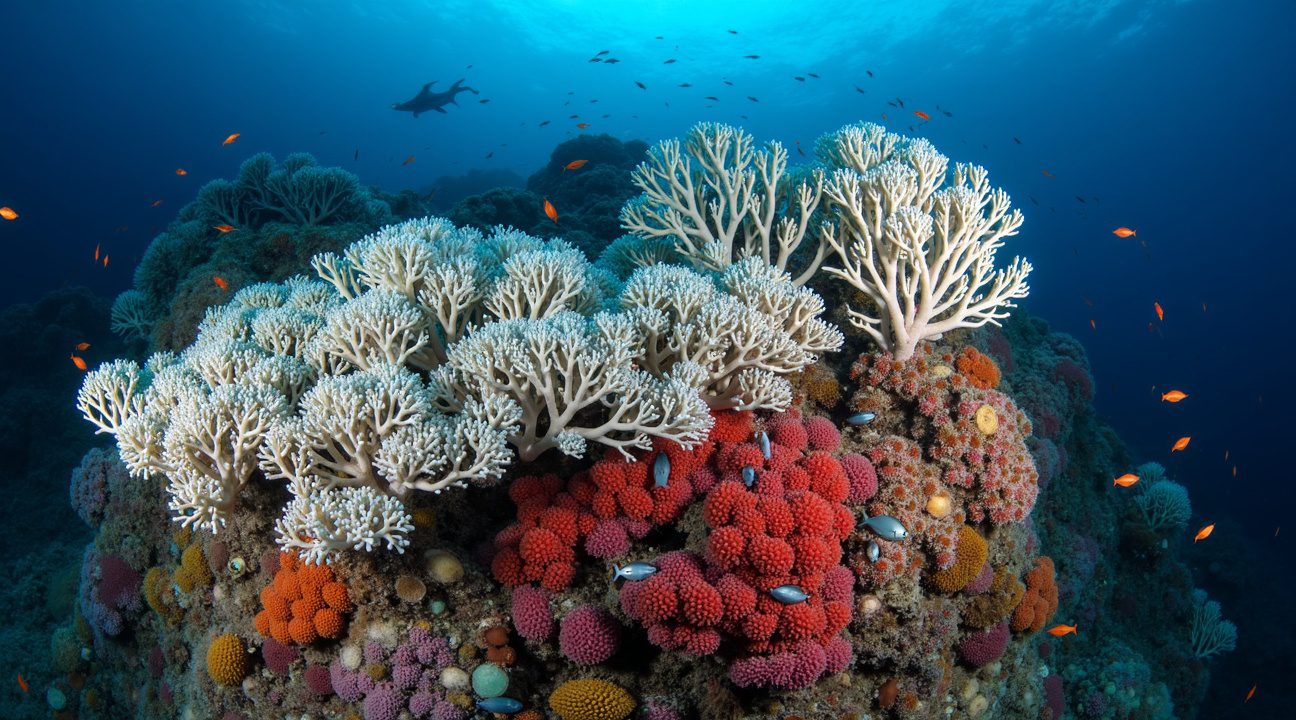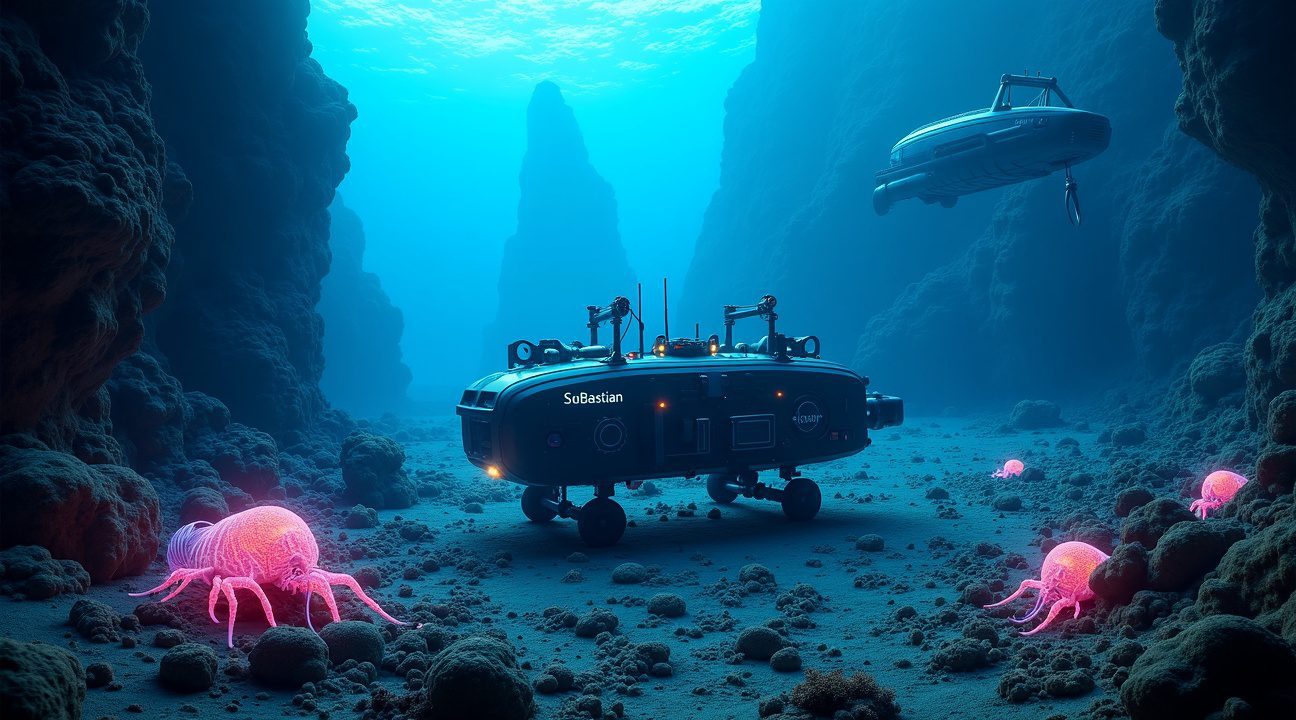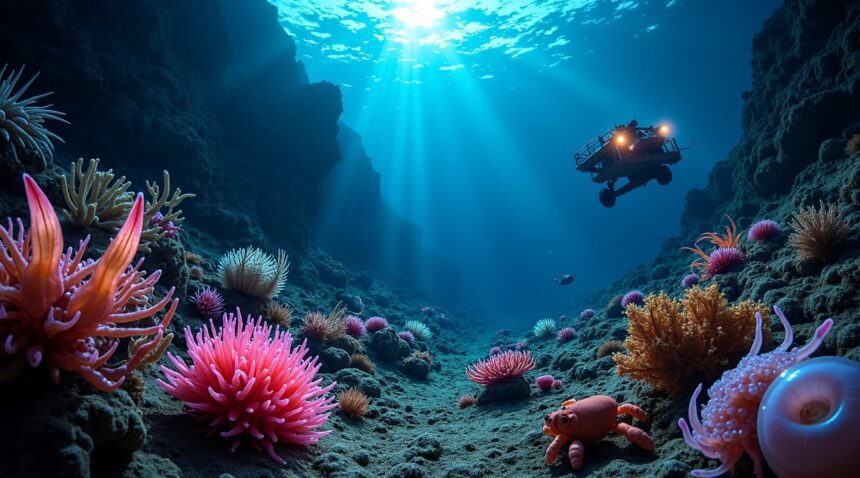Scientists completed the first visual exploration of a deep-sea canyon off Argentina’s coast, revealing an astonishing world teeming with previously unseen life forms and vibrant marine biodiversity.
Discovery of New Species in the Mar del Plata Canyon
The groundbreaking expedition led to the discovery of over 40 potential new species dwelling in the mysterious depths of the Mar del Plata Canyon. Among the discoveries were Barbie-pink lobsters, glass squids with horn-like appendages, and deep-sea corals surviving in extreme conditions.
A Hidden Biodiversity Hotspot
Located off the coast of Argentina, the Mar del Plata Canyon dives over 3,500 meters, making it nearly twice as deep as the Grand Canyon. Its ecosystem is enriched by the Brazil-Malvinas Current confluence, which delivers nutrient-dense waters ideal for diverse marine life.
Key Takeaways
- Over 40 potential new species were discovered, including uniquely colored lobsters, transparent squids, and rare coral species.
- The underwater canyon reaches over 3,500 meters in depth, supported by nutrient flows from the Brazil-Malvinas Current confluence.
- Public engagement soared with nearly 4 million viewers worldwide engaging in the expedition, with 75% tuning in from Argentina.
- The exploration uncovered both pristine habitats and human impact, such as plastic debris scattered across the ocean floor.
- Advanced robotic technology made the mission feasible, with the ROV SuBastian enabling precise navigation and high-definition documentation of this deep-sea realm.
The Role of Technology in Deep-Sea Research
Using state-of-the-art equipment like the Remotely Operated Vehicle (ROV) SuBastian, scientists were able to collect samples and record high-quality footage at depths once beyond our reach. This technological breakthrough marks a significant leap forward in marine exploration.
40 Potential New Species Found in First-Ever Deep-Sea Canyon Exploration
Scientists have made extraordinary discoveries during this groundbreaking expedition, uncovering over 40 potential new species in the previously unexplored depths of the Argentinian Ocean canyon. The remarkable biodiversity found in these waters rivals some of the most significant marine discoveries of recent years, comparable to findings like the deepest fish ever recorded.
Diverse Marine Life Discoveries
The expedition revealed an astonishing variety of marine organisms that highlight the canyon’s rich ecosystem. Key discoveries include:
- Sea anemones displaying unique characteristics not seen in previously documented species
- Sea cucumbers with distinctive morphological features
- Sea urchins exhibiting novel spine patterns and body structures
- Snails with specialized shell formations adapted to extreme depths
- Corals showing remarkable adaptations to the canyon’s specific conditions
- Crinoids demonstrating evolutionary features previously unknown to science
Among the most captivating finds were the vibrant Barbie-pink lobsters, whose striking coloration sets them apart from any known crustacean species. These creatures likely developed their distinctive hue as an adaptation to the canyon’s unique light conditions and chemical environment.
Glass squids with hornlike appendages also captured researchers’ attention, representing a potentially new branch in cephalopod evolution. Their transparent bodies and unusual projections suggest specialized hunting or defensive mechanisms evolved specifically for canyon life.
A king crab covered in numerous barnacles demonstrated the complex symbiotic relationships that develop in isolated deep-sea environments. This discovery provides insight into how species adapt and coexist in extreme conditions, much like the unique ecosystems found in massive sinkholes that harbor undiscovered species.
Perhaps most endearing to the research team was a seastar bearing an uncanny resemblance to Patrick Star from the popular cartoon SpongeBob SquarePants. This discovery, while amusing, represents serious scientific value as it may indicate convergent evolution patterns in deep-sea environments.
This expedition marks the first time researchers have conducted visual exploration of this particular canyon system using advanced deep-sea technology. The cutting-edge equipment allowed scientists to document these species in their natural habitat, providing crucial behavioral and environmental data that wouldn’t be possible through traditional collection methods alone. These findings contribute to our understanding of deep-sea biodiversity and highlight how much remains unknown about our planet’s most remote marine environments.
Argentina’s Hidden Underwater Grand Canyon Twice as Deep as the Famous Landmark
Located approximately 300 kilometers offshore from Mar del Plata, Argentina, the Mar del Plata Canyon represents one of the ocean’s most remarkable geological formations. This underwater canyon plunges to depths exceeding 3,500 meters, making it nearly twice as deep as Arizona’s famous Grand Canyon.
The canyon’s extraordinary depth creates a unique environment that supports an incredible diversity of marine life. Its dramatic underwater topography forms steep walls and deep valleys that provide distinct habitats for different species at various depths. Scientists have long suspected this remote location harbored exceptional biodiversity, but recent explorations have confirmed its status as a biological hotspot.
The Brazil-Malvinas Confluence Effect
The Mar del Plata Canyon’s rich ecosystem owes much of its vitality to the Brazil-Malvinas Confluence, where warm tropical waters from the Brazil Current meet the cold waters of the Malvinas Current. This interaction creates several important conditions that support marine life:
- Upwelling of nutrient-rich waters from the deep ocean
- Temperature gradients that create diverse microhabitats
- Enhanced mixing of water masses that distributes nutrients
- Seasonal variations that support different species throughout the year
- Formation of oceanographic fronts that concentrate prey species
This confluence zone acts as a natural nutrient pump, bringing essential minerals and organic matter from the depths to feed the entire food web. The constant mixing of water masses ensures that both warm-water and cold-water species can find suitable conditions within different areas of the canyon system.
Argentina’s deep-sea ecosystems benefit from this unique positioning, where the canyon serves as a natural laboratory for evolution. The isolated nature of deep-sea environments, combined with the specific conditions created by the current confluence, has allowed species to develop unique adaptations over millions of years.
The canyon’s discovery parallels other significant findings in deep-sea research, such as the deepest fish ever recorded at extreme ocean depths. These findings demonstrate how much scientists still don’t know about our planet’s underwater landscapes.
Recent technological advances in deep-sea exploration have finally allowed researchers to properly investigate this remote canyon system. The combination of remotely operated vehicles, advanced sonar mapping, and specialized collection equipment has opened up new possibilities for studying these extreme environments. Each expedition to the Mar del Plata Canyon reveals new insights about how life adapts to the crushing pressures, perpetual darkness, and unique chemical conditions found in these depths.
Nearly 4 Million Viewers Watched the Live Deep-Sea Discovery
The Schmidt Ocean Institute’s groundbreaking exploration captivated audiences worldwide through live streaming technology, demonstrating how modern deep-sea research can engage the public on an unprecedented scale. Over three weeks of continuous exploration, nearly 4 million viewers tuned in to witness the discovery of new species in real-time, with each dive averaging an impressive 500,000 views.
Argentina dominated the viewership statistics, accounting for 75% of the total audience. This overwhelming national interest reflects how deep-sea exploration can foster scientific curiosity and national pride, particularly when discoveries occur within a country’s territorial waters. The enthusiasm shown by Argentine viewers highlights the powerful connection between scientific discovery and cultural identity.
Advanced Technology Brought the Deep Sea to Living Rooms
The R/V Falkor served as the mission’s command center, while the ROV SuBastian became the star of the show. This remotely operated vehicle carried an array of sophisticated equipment that made the live broadcast possible:
- High-definition cameras captured crystal-clear footage of the ocean floor at depths exceeding 4,000 meters
- Robotic arms allowed real-time specimen collection while viewers watched
- Advanced scientific sensors provided instant data about water temperature, pressure, and chemical composition
- LED lighting systems illuminated the dark depths, revealing vibrant creatures like the deepest fish species ever documented
The live streaming format transformed passive scientific observation into an interactive experience. Viewers could witness the exact moment researchers encountered new species, including the striking Barbie-pink lobsters that became social media sensations. This immediate access to discovery created an emotional connection between the public and marine science that traditional documentaries simply can’t match.
The success of this live deep-sea exploration opens new possibilities for public engagement in scientific research. Just as massive sinkholes and underwater archaeological sites have captured public imagination, live deep-sea expeditions prove that cutting-edge technology can democratize scientific discovery. The viewing numbers demonstrate genuine public appetite for real scientific exploration, suggesting that future missions might benefit from similar streaming approaches.
The ROV SuBastian’s sophisticated capabilities enabled researchers to conduct detailed scientific work while maintaining broadcast quality. Its precision instruments collected specimens that will undergo extensive laboratory analysis, ensuring that the entertainment value never compromised scientific rigor.
Pristine Deep-Sea Coral Reefs Discovered Alongside Human Impact
The recent expedition to the Argentinian Ocean revealed a striking contrast between untouched underwater wilderness and concerning signs of human interference. Scientists encountered remarkable deep-sea coral communities that have thrived in complete isolation for potentially thousands of years, yet these same pristine environments showed unmistakable evidence of mankind’s expanding footprint.
Ancient Coral Gardens Flourishing in the Abyss
At depths exceeding 1,000 meters, researchers documented extensive coral reef systems that challenge conventional understanding of deep-sea biodiversity. The discovery of Bathelia candida colonies at 1,014 meters demonstrated how these calcium carbonate builders create complex three-dimensional structures in complete darkness. These white, branching corals form the foundation for entire ecosystems, providing shelter and feeding grounds for countless species.
Even deeper, at 1,500 meters, vibrant red Anthomastus soft corals painted the seafloor in brilliant crimson hues. Unlike their hard coral counterparts, these flexible organisms sway with deep-ocean currents, their polyps filtering microscopic nutrients from the water column. The presence of both hard and soft coral species at such depths indicates a remarkably stable and productive environment that has remained largely undisturbed.
Scientists observed that these coral gardens support intricate food webs, with newly discovered species occupying specialized niches within the reef structure. The isolation of these communities has allowed for unique evolutionary pathways, resulting in the high levels of endemism documented during the expedition. Similar discoveries of deepest fish species continue to reshape our understanding of life in extreme environments.
Human Footprints in Earth’s Final Frontier
Despite their remote location thousands of meters below the surface, these pristine coral reefs aren’t immune to human influence. The expedition team documented plastic waste scattered throughout the canyon system, serving as a sobering reminder that no corner of Earth remains untouched by human activity. This pollution represents more than an aesthetic concern—plastic debris can physically damage delicate coral structures and introduce toxic chemicals into these sensitive ecosystems.
The contrast between ancient coral formations and modern plastic waste highlights the urgent need for comprehensive marine conservation strategies. These deep-sea environments lack the resilience mechanisms found in shallower ecosystems, making them particularly vulnerable to disturbance. Recovery from damage in these cold, nutrient-limited environments can take decades or centuries.
The findings emphasize that effective conservation must extend far beyond coastal waters and protected shallow reefs. Deep-sea ecosystems like those discovered off Argentina’s coast require international cooperation and specialized protection measures. Current fishing practices, deep-sea mining proposals, and shipping routes all pose potential threats to these newly documented coral communities.
Research teams noted that understanding these ecosystems becomes increasingly critical as human activities expand into deeper waters. The discovery of undiscovered species habitats in various extreme environments demonstrates how much biodiversity remains unknown and unprotected.
Marine biologists stress that these coral reefs represent living libraries of evolutionary history, containing genetic information accumulated over millennia. Each species found within these communities has adapted to extreme conditions of pressure, temperature, and darkness. Protecting these environments preserves not only current biodiversity but also the evolutionary potential for future adaptation to changing ocean conditions.
The expedition’s documentation of both pristine coral gardens and human impact evidence provides crucial baseline data for future monitoring efforts. This information will help scientists track changes in these remote ecosystems and develop targeted conservation strategies. The presence of plastic waste, even at such depths, underscores the global nature of ocean pollution and the need for comprehensive waste management policies.
Conservation efforts must now expand to include these deep-ocean coral communities, ensuring that future generations can study and benefit from these remarkable ecosystems. The delicate balance between exploration and preservation becomes increasingly important as technology enables access to previously unreachable marine environments.

Advanced Technology Reveals Underwater World Using Robotic Exploration
The discovery of over 40 new species beneath the Argentinian Ocean represents a triumph of modern technological capabilities. Scientists utilized cutting-edge equipment from the Schmidt Ocean Institute, including the research vessel R/V Falkor and the sophisticated ROV SuBastian, to penetrate depths previously beyond human reach.
ROV SuBastian served as the expedition’s primary window into this alien environment. The remotely operated vehicle descended into the deep-sea canyon equipped with high-definition cameras that captured crystal-clear footage of previously unknown ecosystems. These cameras documented vibrant pink lobsters, translucent organisms, and countless other species that had never been observed by human eyes.
Sophisticated Equipment Enables Groundbreaking Discoveries
The technological arsenal deployed during this expedition included several critical components that made these discoveries possible:
- High-definition cameras capable of operating under extreme pressure conditions
- Precision robotic arms designed for delicate specimen collection
- Advanced scientific sensors measuring temperature, salinity, and chemical composition
- Real-time data transmission systems connecting surface teams with deep-sea operations
- Specialized lighting systems illuminating the perpetual darkness of canyon depths
Remotely Operated Vehicle technology proved essential for accessing environments where human presence remains impossible. The ROV SuBastian operated at crushing depths where pressure exceeds 100 times that at sea level, temperatures hover near freezing, and complete darkness prevails. Traditional diving methods would have made such exploration entirely unfeasible.
The Schmidt Ocean Institute’s R/V Falkor provided the stable platform necessary for precise ROV operations. This research vessel houses sophisticated control systems that allow operators to manipulate the underwater robot with remarkable precision. Scientists controlled robotic arms to carefully collect specimens while simultaneously recording detailed video documentation of each discovery.
Deep-sea exploration requires instruments capable of withstanding extreme environmental conditions. The expedition’s cameras captured images at resolutions sufficient for detailed species identification, while specialized sensors gathered critical environmental data. This information helps scientists understand the unique conditions that support such diverse biological communities in the deep ocean.
Scientists have long suspected that deep-sea canyons harbor extraordinary biodiversity, but technological limitations previously prevented comprehensive exploration. Similar discoveries have occurred in other remote ocean locations, such as findings of the deepest fish ever recorded, demonstrating how advanced technology continues to reveal ocean secrets.
The expedition’s success stems from the integration of multiple technological systems working in harmony. Real-time data transmission allowed surface teams to direct ROV operations based on immediate observations. Scientists could adjust exploration priorities as discoveries unfolded, maximizing the expedition’s scientific value.
ROV technology continues advancing rapidly, enabling increasingly sophisticated deep-sea research. Modern systems incorporate artificial intelligence to assist with navigation and specimen identification. These improvements promise even more remarkable discoveries in Earth’s least explored environments.
The Argentinian Ocean expedition demonstrates how remotely operated vehicles have revolutionized marine biology. Scientists can now explore environments that would have remained forever inaccessible using traditional methods. Each dive reveals new species and expands understanding of deep-sea ecosystems.
Future expeditions will likely build upon this technological foundation, incorporating even more advanced sensors and AI-driven analysis systems. The success of this mission establishes a template for similar explorations in other remote ocean regions. Scientists anticipate that continued technological development will unveil countless additional species living in Earth’s deepest waters.
The integration of high-definition imaging, precise robotic manipulation, and real-time data collection creates unprecedented opportunities for marine discovery. These technological capabilities transform what was once impossible into routine scientific exploration, opening new frontiers in our understanding of ocean biodiversity.

Sources:
Times of India: “Deep-sea discoveries: Pink lobsters, goofy squid, and 40 new species found in Mar del Plata Canyon”
Earth.com: “Barbie crabs, sea pigs, and 40 new species discovered”
Discover Wildlife: “Humans descend into huge deep-sea canyon for first time”
Seven Seas Media: “Viral Deep-Sea Discovery: Argentina’s Hidden Canyon”
IFLScience: “Massive Offshore Canyon Expedition Discovers Barbie Lobsters, Sea Pigs, And 40 Potential New Species”


